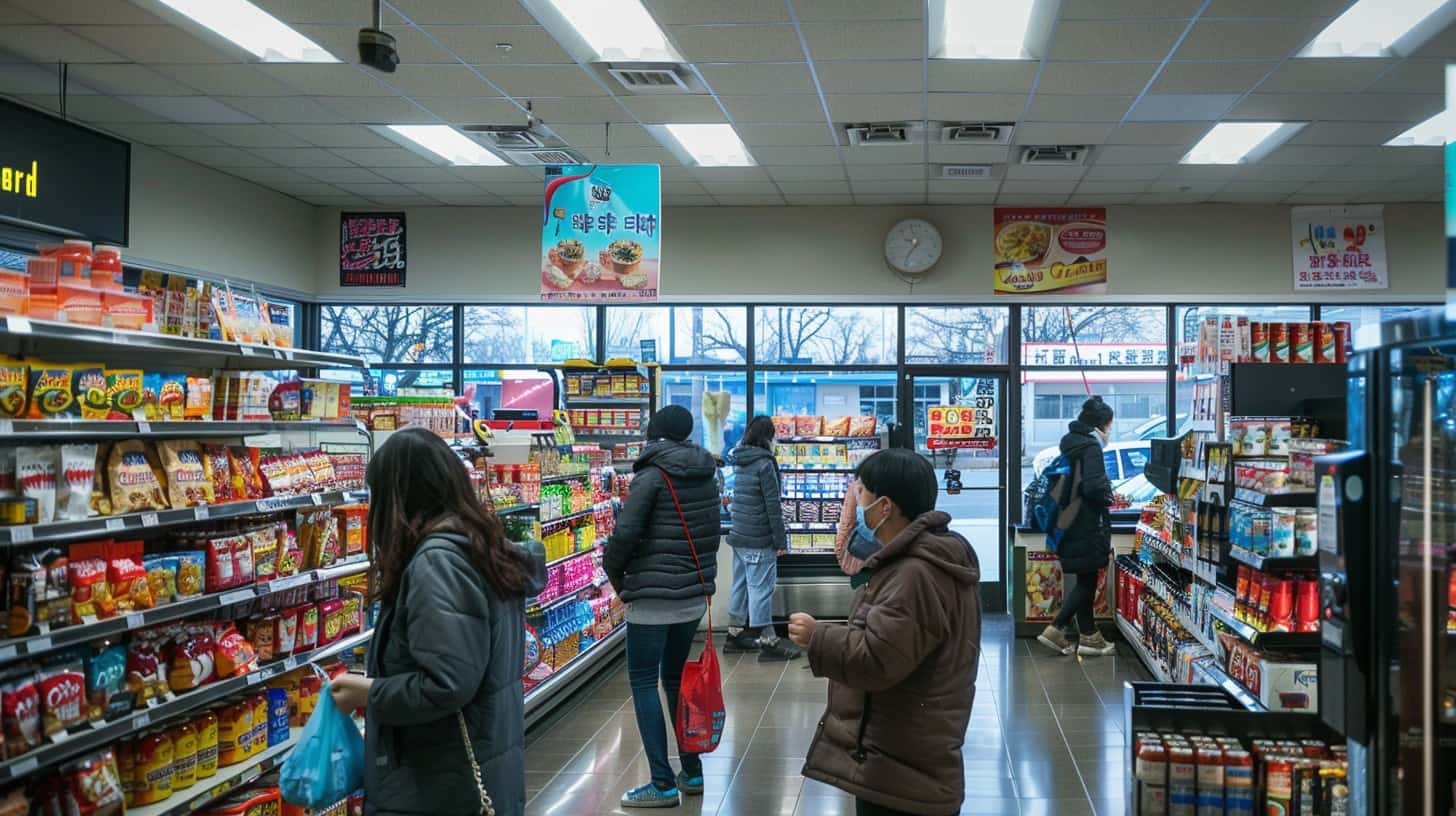Convenience stores are more than just quick stops for snacks. They’re evolving hubs of retail innovation, offering everything from groceries to banking services. These compact shops serve over 160 million customers daily in the U.S. alone, meeting immediate needs and contributing to local economies. 2
As a retail analyst with 15 years of experience, I’ve tracked the transformation of corner stores into versatile mini-markets. From 24-hour operations to expanded product lines, convenience stores are redefining neighborhood commerce.
This article explores their unique features and growing impact on communities. 1
Key Takeaways
Convenience stores serve over 160 million U.S. customers daily, offering quick access to essentials like snacks, groceries, and household items in small retail spaces under 5,000 square feet.
The U.S. has about 150,000 convenience stores, with 120,000 located at gas stations. These stores generated $681.9 billion in sales in 2011 and sell 80% of U.S. fuel.
Japan leads globally with over 55,000 convenience stores as of 2021, offering 24/7 access to fresh food, bill payments, and other services beyond just retail.
Convenience stores are adapting to digital trends with self-checkout kiosks, mobile payments, and expanded product ranges including fresh and healthy options to compete with online retailers.
83% of items bought at convenience stores are consumed within an hour of purchase, highlighting their role in meeting immediate consumer needs.
Table of Contents
Defining Convenience Stores
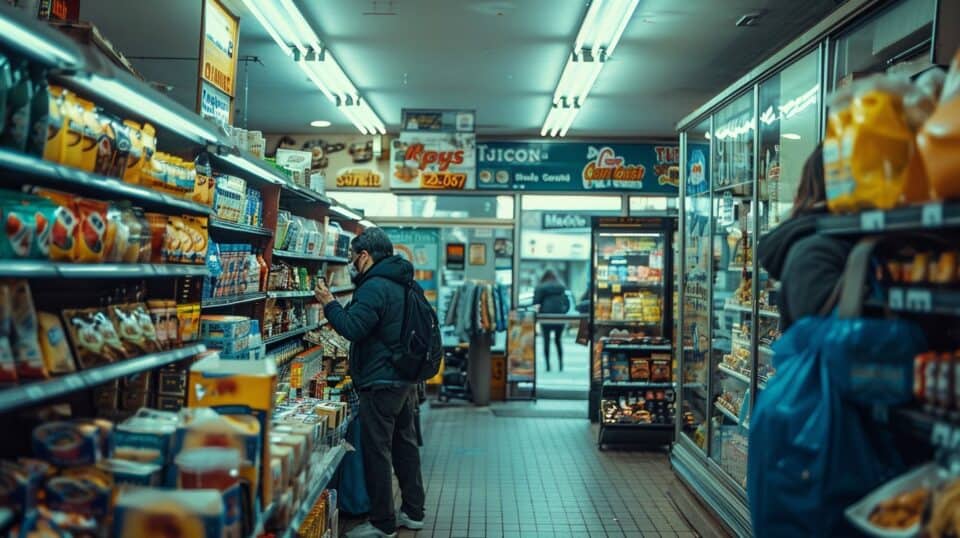
Convenience stores are small retail shops offering everyday essentials. They’re the go-to spots for quick purchases, typically open long hours. These stores stock a limited range of products – from snacks to household items.
You’ll find them in easily accessible locations, like street corners or gas stations. 1
Convenience stores satisfy impulses quickly. – NACS 2
The ExtraMile convenience store exemplifies this retail format. They provide a handy solution for immediate needs. Convenience stores differ from supermarkets in size and product variety.
Let’s explore the key features that set these stores apart.
Key Features of Convenience Stores
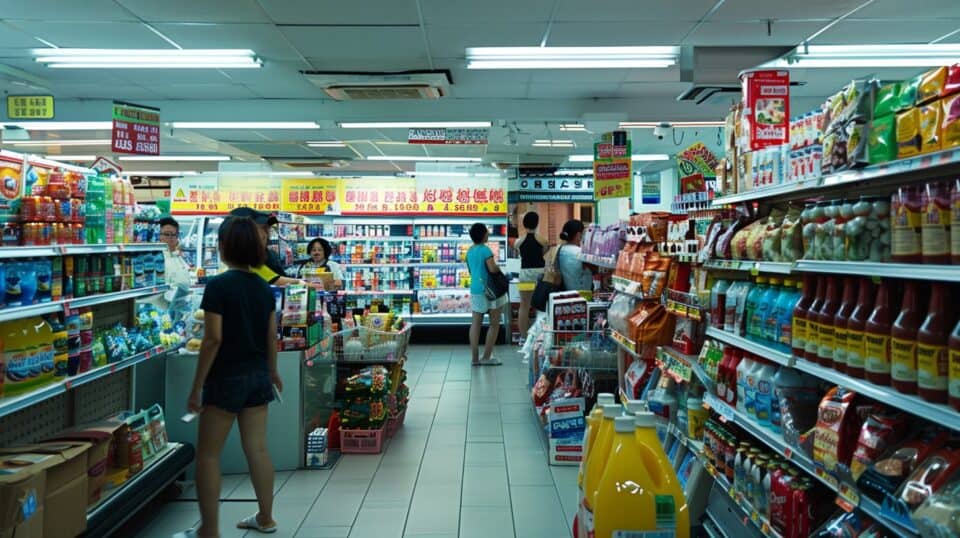
Convenience stores stand out with their unique features. They offer quick access to everyday items and services, making life easier for busy shoppers.
Limited Product Lines
Convenience stores pack a punch with their limited product lines. These shops stock fast-moving consumer goods that fly off the shelves. You’ll find at least 500 different items, from snacks and drinks to basic household essentials. 1 The focus? High-turnover products with long shelf lives.
Perishables are kept to a minimum in these compact spaces. Think packaged foods, beverages, and everyday necessities – not fresh produce or gourmet ingredients. This streamlined approach lets c-stores maximize their small footprints while meeting customers’ immediate needs.
It’s all about quick trips and grab-and-go convenience for busy women on the move. 3
Extended Hours of Operation
Convenience stores shine with their extended hours. Many stay open 24/7, catering to busy moms and night owls alike. 5 These shops fill a crucial gap, offering essentials when other stores close.
Late-night diaper runs or early morning coffee stops become hassle-free.
Convenience stores are the unsung heroes of modern life, always there when you need them most.
Flexible hours mean more than just convenience. They create jobs, boost local economies, and serve as community hubs. 4 For shift workers and travelers, these stores provide a lifeline.
Next, let’s explore the types of convenience stores you might encounter.
Convenient Store Locations
Convenience stores pop up in high-traffic areas. You’ll spot them near busy intersections, residential neighborhoods, and transport hubs. Their strategic locations cater to immediate needs – perfect for grabbing essentials on your commute home.
These shops thrive in urban centers, suburbs, and even rural communities. 6
Gas stations often house convenience stores, creating one-stop shops for fuel and snacks. The average U.S. convenience store packs a lot into 2,768 square feet of sales space. Newer stores go bigger, averaging 2,800 square feet for sales and 1,900 square feet for storage and operations.
This compact design maximizes efficiency in prime locations. 7
Importance of Convenience Stores

Convenience stores play a vital role in our daily lives, offering quick access to essentials and snacks… Read on to discover how these neighborhood shops impact local economies and meet consumer needs.
Access for Immediate Needs
Convenience stores meet urgent needs for essential items. They offer quick access to groceries, snacks, and household goods 24/7. These shops stock everyday necessities like milk, bread, and toiletries.
Their strategic locations in neighborhoods make them ideal for last-minute purchases.
Women often rely on these stores for feminine hygiene products or baby supplies. The stores’ extended hours cater to busy schedules and unexpected situations. While convenient, these shops may promote unhealthy eating habits.
Studies link proximity to convenience stores with poor dietary choices in children. 8 The easy availability of high-fat foods and sugary drinks can impact community health. 9
Economic Contributions to Local Communities
Beyond meeting immediate needs, convenience stores play a crucial role in local economies. These small businesses create jobs and generate tax revenue for communities. In the U.S., the industry’s $681.9 billion in sales in 2011 translated into significant economic impact. 10 Local shops often source products from nearby suppliers, fostering a cycle of regional economic growth.
Convenience stores also serve as social hubs, especially in rural areas. They provide essential services like ATMs, lottery tickets, and money orders. Australia’s 6,000+ convenience stores employ over 40,000 people, contributing $8.4 billion in merchandise sales (excluding petrol) in 2017.
This demonstrates their substantial economic footprint even in smaller markets. 11
Types of Convenience Stores
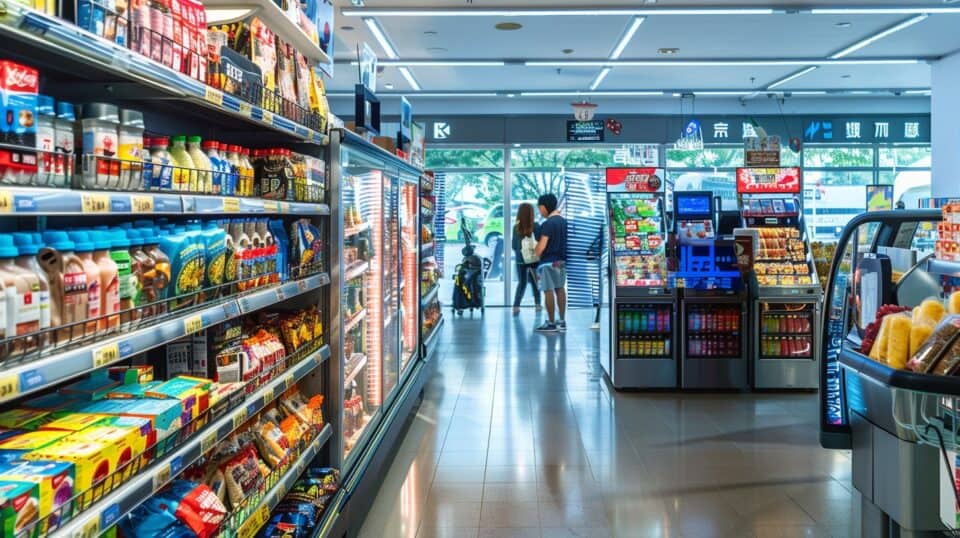
Convenience stores come in different shapes and sizes… From corner shops to gas station marts, each type serves a unique purpose. Want to know more about these store varieties?
Independent Standalone Stores
Independent standalone convenience stores have been a staple in American communities since the 1920s. 12 These small shops offer quick access to everyday essentials, often in residential areas or busy street corners.
They’re typically family-owned businesses, providing a personal touch that larger chains can’t match.
QMart in Houston, Texas, leads the way in modernizing these standalone stores. 12 They’ve embraced digital payment systems, expanded product ranges, and improved store layouts. This innovation helps them compete with bigger retailers while maintaining their local charm.
“Our goal is to blend convenience with community,” says a QMart spokesperson. “We’re not just a store – we’re your neighbors. 1
Gas Station-Based Convenience Stores
Gas station-based convenience stores dominate the U.S. market. A staggering 120,000 out of 150,000 convenience stores are located at fuel stations. These mini-marts sell 80% of U.S. fuels, making them crucial pit stops for drivers.
Women often rely on these stores for quick snacks, drinks, and essentials while refueling. 1
These shops offer a unique blend of fuel and retail services. Customers can grab a coffee, pick up milk, or buy a lottery ticket while filling up their tanks. The convenience factor is huge – no need for separate trips.
Kiosk-style convenience stores offer a different experience, catering to pedestrians in urban areas. 13
Kiosk-Style Convenience Stores
Kiosk-style convenience stores offer quick, self-service shopping. These compact units stock essentials and snacks in high-traffic areas. Self-checkout kiosks are gaining popularity, with 60% of customers preferring them for a contactless experience. 14
The self-service kiosk market hit $12.05 billion in 2020. 14 It’s projected to reach $21.42 billion by 2027. This growth reflects increasing demand for efficient, automated retail solutions in busy urban environments. 1
Comparing Convenience Stores with Other Retail Formats
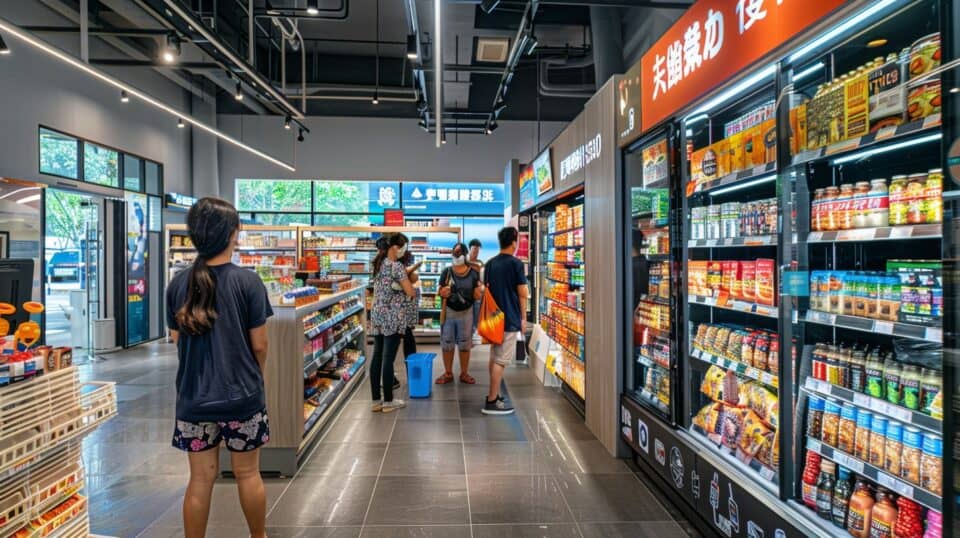
Convenience stores offer quick access to essentials, unlike supermarkets’ vast selections. They differ from grocery stores by focusing on grab-and-go items and extended hours, meeting unique consumer needs.
Convenience Stores vs. Supermarkets
Convenience stores and supermarkets serve different purposes in our daily lives. Let’s compare:
| Aspect | Convenience Stores | Supermarkets |
|---|---|---|
| Size | Small, typically under 5,000 sq ft | Large, often over 40,000 sq ft |
| Product Range | Limited, focus on grab-and-go items | Extensive, thousands of products |
| Operating Hours | Extended, often 24/7 | Standard business hours |
| Location | Easily accessible, residential areas | Often in shopping centers or standalone |
| Pricing | Higher due to convenience factor | Generally lower, bulk options available |
| Shopping Experience | Quick, in-and-out | Longer, planned trips |
| Target Audience | Travelers, on-the-go customers | Families, bulk shoppers |
| New Trends | Local, sustainable products, premium wines | Online ordering, curbside pickup |
Stores cater to different needs. C-stores offer speed and accessibility. Supermarkets provide variety and value. Both play crucial roles in our shopping habits. 1516
Convenience Stores vs. Grocery Stores
Convenience stores and grocery stores serve different consumer needs. Let’s compare:
| Feature | Convenience Stores | Grocery Stores |
|---|---|---|
| Size | Smaller footprint, avg. 2,500 sq ft | Larger, avg. 45,000 sq ft |
| Product range | Limited, focus on essentials | Wide variety, full grocery selection |
| Hours | Extended, often 24/7 | Standard business hours |
| Location | Easily accessible, urban areas | Suburban, larger parking lots |
| Pricing | Higher, convenience premium | Lower, bulk discounts |
| Shopping experience | Quick, grab-and-go | Longer, planned trips |
| Sales volume | $195 billion (2011, in-store) | $682.7 billion (2021, total) |
Convenience stores excel in quick purchases. 17 Grocery stores offer more options for weekly shopping. 18 Each serves a unique purpose in the retail landscape.
Global Perspectives on Convenience Stores
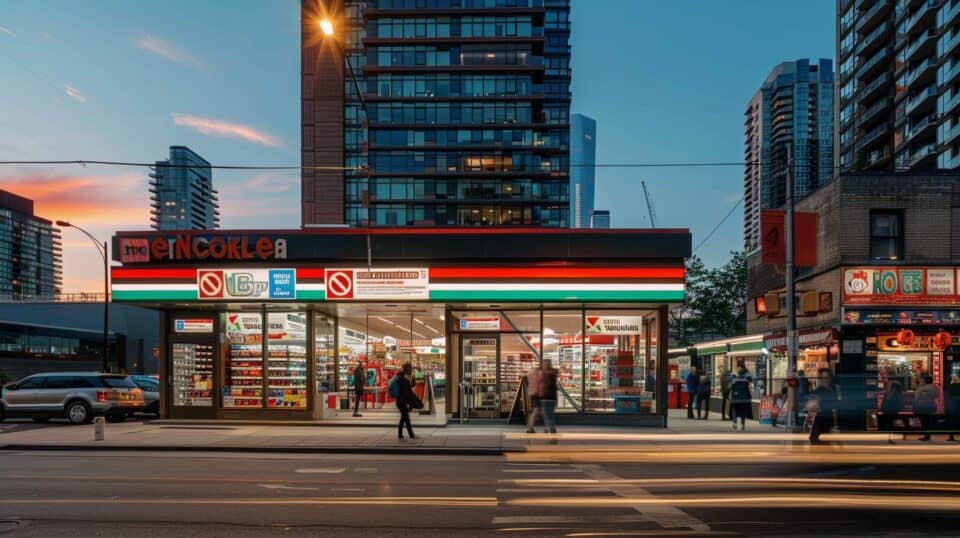
Convenience stores look different across the globe. From Japan’s 24-hour konbini to Canada’s dépanneurs, each country puts its own spin on quick shopping.
Convenience Stores in the United States
U.S. convenience stores have come a long way since the first chain opened in Dallas, Texas in 1927. Today, these shops dot street corners and gas stations across the country, offering quick access to snacks, drinks, and everyday essentials. 19 Circle K, founded in 1951, stands as one of the most recognizable names in the industry.
American c-stores cater to busy lifestyles with extended hours and strategically placed locations. They’ve evolved beyond basic necessities, now featuring fresh food options, coffee bars, and even mobile payment systems.
Many partner with gas stations, creating one-stop shops for fuel and groceries. Despite competition from online retailers, these stores continue to thrive by adapting to changing consumer needs and embracing technological advancements. 11
Convenience Stores in Japan
Japan boasts a staggering 55,000+ convenience stores as of October 2021. 20 These “konbini” are more than just shops – they’re a cultural phenomenon. 7-Eleven leads with 12,467 stores, followed by Lawson (9,562) and FamilyMart (7,604).
Japanese konbini offer an array of services: ATMs, bill payments, ticket purchases, and even dry cleaning. 21 They’re open 24/7, providing everything from fresh bento boxes to umbrellas in a pinch.
Next, let’s explore how convenience stores differ in other countries.
Convenience Stores in the United Kingdom
Convenience stores in the UK play a vital role in local communities. With 49,388 shops across the country, these small retailers offer quick access to essentials. 23 The Co-operative Group stands out as the second-largest chain, providing a familiar presence on many street corners.
These stores cater to busy lifestyles, stocking everything from milk and bread to newspapers and toiletries.
UK convenience stores adapt to changing consumer needs. Many now offer fresh produce, ready meals, and even small cafés. Extended hours – often 6 AM to 11 PM or later – make them go-to spots for last-minute purchases. 22 Their compact size and strategic locations near homes and workplaces make them ideal for grab-and-go shopping trips.
Convenience Stores in Canada
Convenience stores in Canada offer quick, accessible shopping. Couche-Tard Inc. dominates the market with over 500 locations, while 7-Eleven spans from British Columbia to Ontario. 24 These stores cater to busy women, providing essentials and snacks 24/7. Canadian convenience stores often feature unique items like poutine and maple syrup products, reflecting local tastes.
The industry faces challenges from online retailers, but adapts with expanded services and digital integration. 25 Let’s explore how convenience stores in other countries compare to Canada’s offerings.
Convenience Stores in Australia
Australia boasts over 6,000 convenience stores, employing more than 40,000 people. 26 These shops, scattered across cities and suburbs, provide quick access to essentials. 7-Eleven, Ampol, and NightOwl dominate the Aussie market, offering a mix of snacks, drinks, and everyday items. 27 Let’s explore how these stores compare to their global counterparts.
Evolution of Convenience Stores

Convenience stores have come a long way since their humble beginnings. They’ve grown from simple corner shops to tech-savvy hubs, adapting to changing consumer needs.
Historical Background of Convenience Stores
Convenience stores trace their roots to 1927 in Dallas, Texas. The Southland Ice Company pioneered this retail format, selling everyday items alongside ice. 28 Their innovation quickly caught on, meeting the growing demand for accessible, quick shopping.
By 1951, Circle K entered the scene, marking a new era in convenience retail. The chain’s rapid growth led to $1 billion in sales by 1966. 12 This success sparked a nationwide trend, with convenience stores popping up on corners and gas stations across America.
These shops filled a crucial niche, offering essentials during off-hours when larger stores were closed.
Adapting to Digital Advances
Convenience stores are embracing digital innovations to stay competitive. Mobile payment options and self-checkout systems now streamline transactions for busy shoppers. 5 Many stores have launched e-commerce platforms, partnering with delivery services to bring snacks and essentials right to customers’ doorsteps. 5 These tech upgrades aim to enhance the quick, easy shopping experience that convenience stores are known for.
Digital advances are reshaping how convenience stores operate and serve their communities. The next section explores the challenges these neighborhood shops face in today’s rapidly changing retail landscape. 29
Challenges Facing Convenience Stores
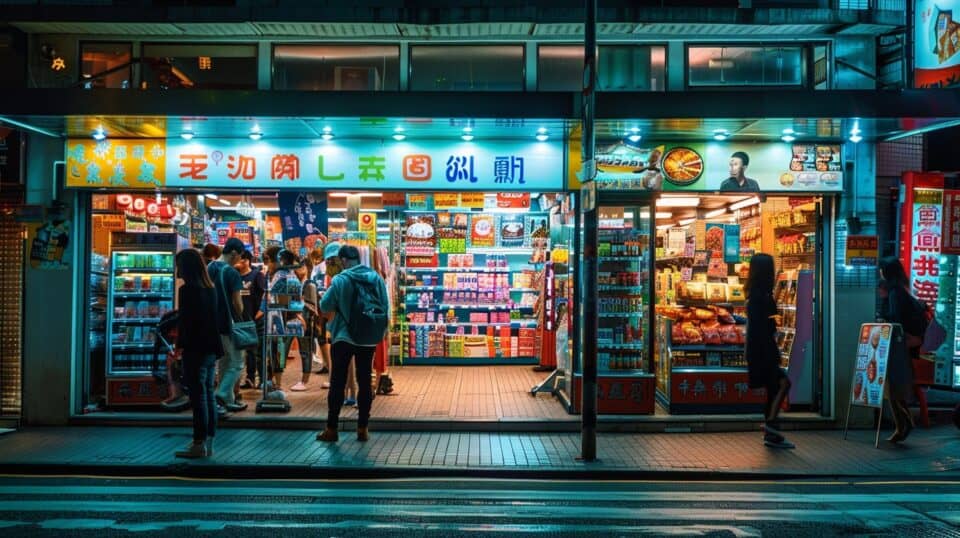
Convenience stores face tough competition from online retailers. They must also follow strict health and safety rules… These challenges push store owners to innovate and adapt.
Competition with Online Retailers
Online retailers pose a serious threat to convenience stores. E-commerce giants offer vast product selections and doorstep delivery, challenging the traditional “quick-stop” model. 31 Convenience stores must adapt to survive. Many now partner with delivery apps or create their own online platforms. Some focus on unique local offerings that can’t be found online. 30 Others leverage their physical presence by becoming pickup points for online orders.
Convenience stores still have advantages. They provide instant gratification for immediate needs. Their locations often beat delivery times in urban areas. To stay competitive, stores are expanding fresh food options and embracing technology.
Self-checkout kiosks, mobile payments, and loyalty programs enhance the customer experience. The key is balancing digital innovation with the personal touch that keeps customers coming back.
Compliance with Health and Safety Regulations
Convenience stores face strict health and safety regulations. Food safety is a top priority, especially for prepared foods. 32 Government oversight ensures quality standards are met. 32 Stores must follow rigorous cleaning protocols, maintain proper food temperatures, and train staff in safe handling practices. Regular inspections check for compliance with health codes.
Failure to meet these standards can result in fines or closure.
Safety measures extend beyond food. Stores must provide well-lit environments, clear exits, and fire safety equipment. Employee safety training is mandatory. 33 Proper storage of chemicals and hazardous materials is crucial.
Many stores now use security cameras and have cash handling procedures to protect staff and customers. The next section explores future trends shaping the convenience store industry.
Future Trends in Convenience Stores
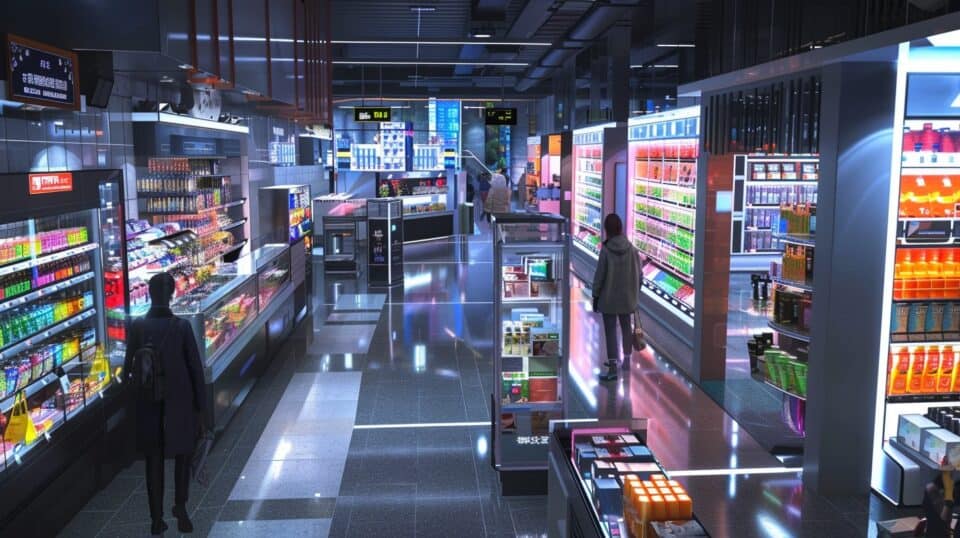
Convenience stores are set to transform with tech. Smart shelves and AI will change how we shop.
Technological Integration in Convenience Stores
Convenience stores are embracing tech to boost efficiency and customer experience. Self-checkout kiosks, mobile payment options, and digital loyalty programs streamline transactions and personalize shopping.
80% of in-store shoppers prefer these nontraditional checkout methods. 34 Smart shelves with digital price tags, inventory management systems, and AI-powered analytics help stores optimize stock levels and reduce food waste. 29 These innovations redefine convenience, potentially improving stores’ bottom lines while meeting modern consumers’ expectations for quick, hassle-free shopping.
Expanding Product Ranges in Convenience Stores
Convenience stores are shaking things up. Gone are the days of just chips and soda… now you’ll find fresh salads, gourmet sandwiches, and even sushi rolls. These shops are transforming into mini-supermarkets, stocking everything from organic produce to artisanal cheeses.
It’s a game-changer for busy women who need quick, healthy options on the go. 35
This expansion isn’t just about food. Many stores now offer services like bill payment, dry cleaning drop-off, and even small electronics. It’s one-stop shopping at its finest – perfect for multitasking moms and career women alike.
Next up, let’s explore how technology is reshaping the convenience store experience. 7
People Also Ask
What are convenience stores?
Convenience stores, also known as c-stores, are small retail shops. They sell everyday items like snacks, drinks, and basic groceries. You’ll find them in neighborhoods, gas stations, and busy areas.
How do convenience stores differ from other shops?
C-stores are open longer hours than regular stores. They’re smaller than supermarkets but bigger than kiosks. These shops focus on quick, easy shopping. You’ll find essentials, not full grocery selections.
What can I buy at a convenience store?
Most c-stores sell snacks, drinks, and cigarettes. Many offer hot food like hot dogs or fry-ups. Some have ATMs, lottery tickets, and adult magazines. You might find French bread, milk, and other basics too.
How are convenience stores changing?
Modern c-stores are evolving. Many now offer fresh food and coffee. Some have partnered with fast-food chains. Digital payments and self-checkouts are becoming common. Stores are focusing more on healthy options and local products.
Are convenience stores the same worldwide?
No, c-stores vary by country. In Japan, they’re called konbini and offer many services. Bodegas are popular in New York. The UK has corner shops and off-licences. Indonesia has minimarkets. Each type reflects local needs and culture.
How do convenience stores impact communities?
C-stores play a big role in neighborhoods. They provide quick access to essentials. In rural areas, they might be the only nearby shop. They create jobs and serve as community hubs. But they can also face issues like shoplifting and food spoilage.
References
- ^ https://www.convenience.org/Research/Convenience-Store-Fast-Facts-and-Stats/What-is-a-Convenience-Store
- ^ https://www.bcg.com/publications/2014/retail-marketing-sales-evolving-convenience-store-consumer (2014-02-18)
- ^ https://www.ncbi.nlm.nih.gov/pmc/articles/PMC9549368/
- ^ https://www.convenience.org/Topics/Community/Convenience-Stores-and-Their-Communities/Store-Operations
- ^ https://treendly.com/blog/convenience-store-evolution-uncovering-the-rise-of-innovative-offerings-and-tech-driven-solutions (2023-08-18)
- ^ https://www.researchgate.net/publication/242336935_Convenience_store_location_planning_and_forecasting_-_A_practical_research_agenda
- ^ https://www.intouchinsight.com/blog/top-trends-from-c-store-report/ (2024-06-11)
- ^ https://www.ncbi.nlm.nih.gov/pmc/articles/PMC7988541/
- ^ https://www.researchgate.net/publication/293330820_The_association_between_accessibility_of_local_convenience_stores_and_unhealthy_diet
- ^ https://www.lilanduseandzoning.com/wp-content/uploads/sites/128/2020/01/How-Stores-Work.pdf
- ^ https://www.convenience.org/Topics/Community/Convenience-Stores-and-Their-Communities
- ^ https://qmartstores.com/the-history-of-the-convenience-store/convenience-store/
- ^ https://www.ibisworld.com/united-states/market-research-reports/gas-stations-with-convenience-stores-industry/
- ^ https://www.connectpos.com/self-service-kiosks-redefining-retail-convenience/ (2023-10-26)
- ^ https://www.smu.edu/-/media/site/cox/faculty/research/foxedward/evolution-of-retail-formats-past-present-and-future-2021.pdf
- ^ https://www.ncbi.nlm.nih.gov/pmc/articles/PMC10830372/
- ^ https://atlanticdominiondistributors.com/blog/why-convenience-stores-are-becoming-a-go-to-destination-for-grocery-shopping/ (2023-03-30)
- ^ https://www.indianretailer.com/article/retail-business/retail/difference-between-grocery-and-convenience-store
- ^ https://www.convenience.org/Research/Convenience-Store-Fast-Facts-and-Stats/FactSheets/IndustryStoreCount (2024-01-23)
- ^ https://www.bokksu.com/blogs/news/a-deep-dive-into-japanese-convenience-stores-more-than-just-a-quick-stop (2024-04-18)
- ^ https://www.linkedin.com/pulse/immersive-branding-how-japanese-convenience-stores-d-oria-di-cirie
- ^ https://www.ibisworld.com/united-kingdom/market-research-reports/convenience-stores-industry/
- ^ https://theconversation.com/britains-corner-shops-survived-a-pandemic-and-competition-from-supermarkets-now-they-are-expanding-233816
- ^ https://www.ibisworld.com/canada/market-research-reports/convenience-stores-industry/
- ^ https://www.researchgate.net/publication/343108227_A_Longitudinal_Study_of_American_and_Canadian_Convenience_Store_Marketing_Strategies
- ^ https://www.ibisworld.com/au/industry/convenience-stores/1835/
- ^ https://www.ibisworld.com/au/industry/convenience-stores/14645/
- ^ https://www.kpiconcepts.com/about-us/blog/history-of-convenience-stores-in-the-united-states
- ^ https://www.itsallgoodsinc.com/insights/the-role-of-technology-in-modernizing-convenience-store-food-services
- ^ https://medium.com/@garypryor/the-game-changers-how-new-concepts-can-revitalize-convenience-stores-d42c61629fc8
- ^ https://link.springer.com/article/10.1007/s11846-022-00566-0
- ^ https://www.ncbi.nlm.nih.gov/pmc/articles/PMC10839956/
- ^ https://www.readyconvenience.com/articles/compliance-risks-convenience-stores/
- ^ https://www.forbes.com/sites/forbestechcouncil/2024/03/19/the-future-of-technology-integration-in-convenience-store-food-service/ (2024-03-19)
- ^ https://www.dmnews.com/convenience-stores-embracing-modern-trends/ (2023-10-13)
- ^ https://missionpeakbrokers.com/most-popular-convenience-store-items/
- ^ https://cayugadisplays.com/us/blog/how-convenience-stores-are-evolving-updated-for-2022 (2022-10-26)
- ^ https://www.efinancialmodels.com/convenience-store-plan-unlocking-the-secrets-for-success/ (2024-04-11)
